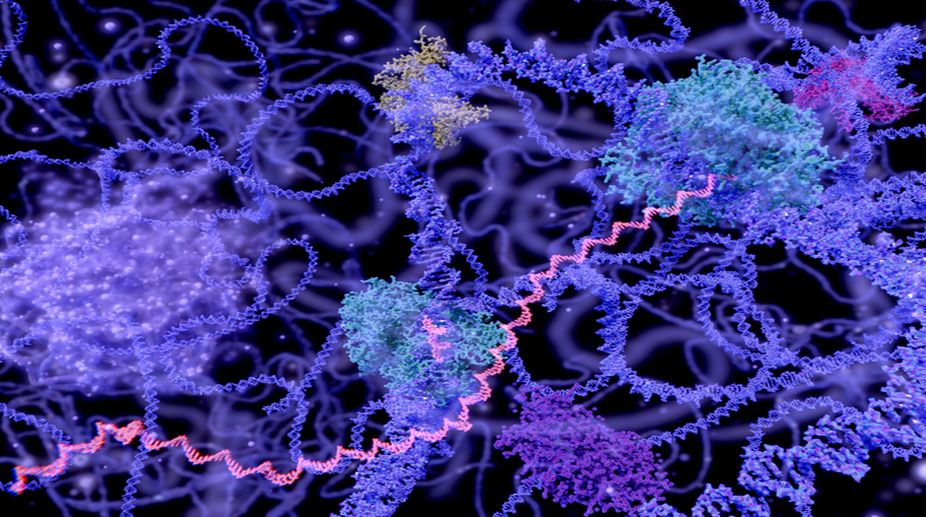Maharashtra bus accident: Bodies to be identified through DNA testing
According to officials, the bus was travelling from Maharashtra's Yavatmal to Pune and met with an accident in Buldhana on the Samruddhi Mahamarg Expressway.

Representational Image (PHOTO: GETTY IMAGES)
Genome-level control is involved in making the eukaryotic genome — chromosomal DNA — accessible to the cell’s transcription machinery. To initiate transcription, a eukaryotic RNA polymerase must interact with both DNA and a number of specific proteins (general transcription factors) in the promoter region of a gene. Except when a gene is being transcribed, its promoter region is embedded within a highly folded and ordered chromatin superstructure. Thus, some degree of chromatin decondensation (unfolding) appears to be necessary for the expression of eukaryotic genes.
The earliest evidence that chromatin decondensation is required for gene transcription came from direct microscopic visualisation of certain types of insect chromosomes caught in the act of transcription. Because the DNA of most eukaryotic cells is dispersed throughout the nucleus as a mass of intertwined chromatin fibres, it is usually difficult to observe the transcription of individual genes with a microscope.
But a way around this obstacle is provided by an unusual type of insect cell. In the fruit fly Drosophila melanogaster and related insects, metabolically active tissues (such as the salivary glands and intestines) grow by an increase in the size of, rather than the number of, their constituent cells. This process generates giant cells whose volumes are thousands of times greater than normal. The development of giant cells is accompanied by successive rounds of DNA replication but because this replication occurs in cells that are not dividing, the newly synthesised chromatids accumulate in each nucleus and line up in parallel to form multi-stranded structures called polytene chromosomes.
Each polytene chromosome contains the multiple chromatids generated during replication of both members of each homologous chromosome pair. The four giant polytene chromosomes found in the salivary glands of Drosophila larvae, for example, are generated by ten rounds of chromosome replication. Ten doublings of each chromatid produces 210 = 1024 chro-matids, so a polytene chromosome containing both members of a homologous chromosome pair would possess a total of 1024 + 1024 = 2048 chromatids aligned next to each other.
Polytene chromosomes are thus enormous structures measuring hundreds of micrometres in length and several micrometres in width — roughly ten times longer and a hundred times wider than the metaphase chromosomes of typical eukaryotic cells. The micrograph shows several polytene chromosomes from the nucleus of a Drosophila salivary gland cell. Visible in each polytene chromosome is a characteristic pattern of dark bands. Each band represents a chromatin domain that is highly condensed compared with the chromatin in the “inter-band” regions between the bands. Activation of the genes of a given chromosome band causes the compacted chromatin strands to uncoil and expand outward, resulting in a chromosome puff. Such puffs consist of DNA loops that are less condensed than the DNA of bands elsewhere in the chromosome. Though puffs are not the only sites of gene transcription along the polytene chromosome, the extent of chromosome decondensation, correlates well with the enhancement of transcriptional activity at these sites.
Advertisement
As the Drosophila larva proceeds through development, each of the polytene chromosomes in salivary gland nuclei undergoes reproducible changes in puffing patterns, under the control of an insect steroid hormone called ecdysone. This hormone functions by binding to, and thus activating, a regulatory protein that stimulates the transcription of certain genes.
It appears, in other words, that the characteristic puffing patterns seen during the development of Drosophila larvae are direct visual manifestations of the selective decondensation and transcription of specific DNA segments according to a genetically determined developmental programme.
The writer is Associate Professor, Head, Department of Botany, Ananda Mohan College, kolkata, and also fellow, Botanical Society of Bengal, and can be contacted at tapanmaitra59@yahoo.co.in.
Advertisement